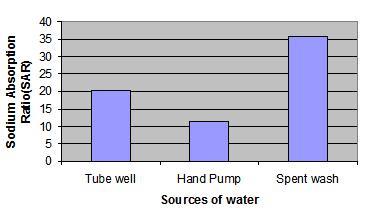
2 minute read
pH portable pH meter (Orion-ISE Model-SA-720 USA
from Effect of Distillery Spent-wash on Channel Bed and Groundwater Quality: Case Study of Unicol Distill
Magnesium (Mg)
The Magnesium content in groundwater samples collected from hand pumps and tube wells in surrounding areas of spent wash channel bed was examined and compared with magnesium content of spent wash. The data (Figure 12) exhibited that the lowest magnesium content (465.3 ppm) was determined in groundwater samples collected from hand pump; and the magnesium content in tube well water was significantly higher (553.3 ppm) than the water samples collected from hand pump water; while the exceptionally high magnesium content (1300.7 ppm) was recorded in spent wash. This suggested that magnesium quantities in spent wash were extremely higher than the groundwater samples apart from the source of water. The differences in Magnesium content between tube well and hand pump waters were also significant (P<0.05) indicated that the deeper water contained relatively higher magnesium contents as compared to shallow waters of hand pumps.
Advertisement
Fig.12: Groundwater analysis for Magnesium (ppm) obtained from different water sources as compared to spent wash channel bed
Sodium absorption ratio (SAR)
The sodium absorption ratio (SAR) of groundwater collected from hand pumps and tube wells in adjacent areas of spent wash channel bed was examined and compared with SAR of spent wash. The data (Figure 13) revealed that the lowest SAR (11.583) was analysed in groundwater samples collected from hand pump; and the SAR of tube well water was markedly higher (20.390) than the water samples collected from hand pump water; while the outstandingly high SAR (35.693) was analysed in spent wash. This suggested that SAR of spent wash was enormously higher than the groundwater samples and direct use of spent wash would not be useful. The differences in SAR for tube well and hand pump water were significant (P<0.05) indicated that the SAR was higher for deeper waters as compared to hand pumps.
Fig.13: Groundwater analysis for SAR obtained from different water sources as compared to spent wash channel bed

Calcium (Ca)
The calcium content in groundwater of hand pumps and tube wells in the adjoining areas of spent wash channel bed was determined and compared with calcium content of spent wash. The data (Figure 14) indicated that the lowest calcium content (359.33 ppm) was observed in groundwater samples collected from tube well; and the calcium content in hand pump water was significantly higher (593.33 ppm) as compared to tube well water; while the spent wash contained superbly high (764.33 ppm). This indicated that calcium contents in spent wash were extremely higher than the groundwater samples apart from the source of water. The differences in calcium content between tube well and hand pump waters were also significant (P<0.05) indicated that the shallow water of hand pump contained significantly higher calcium as compared to deep waters of tube well. In view of the spent wash determination for calcium content, it is argued that without treatment of spent wash, its direct use would be harmful for the crops.

Fig.14: Groundwater analysis for Calcium (ppm) content obtained from different water sources as compared to spent wash channel bed






